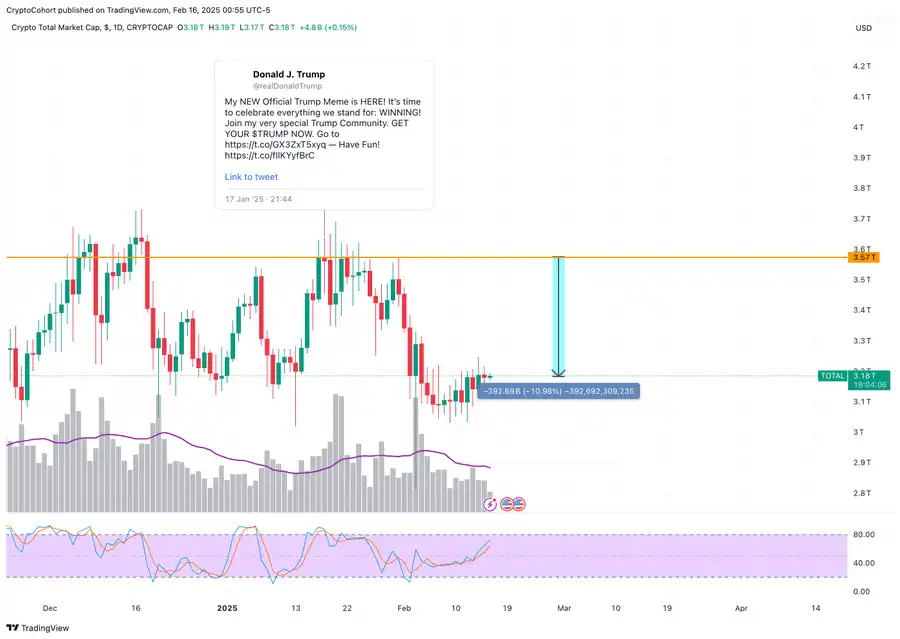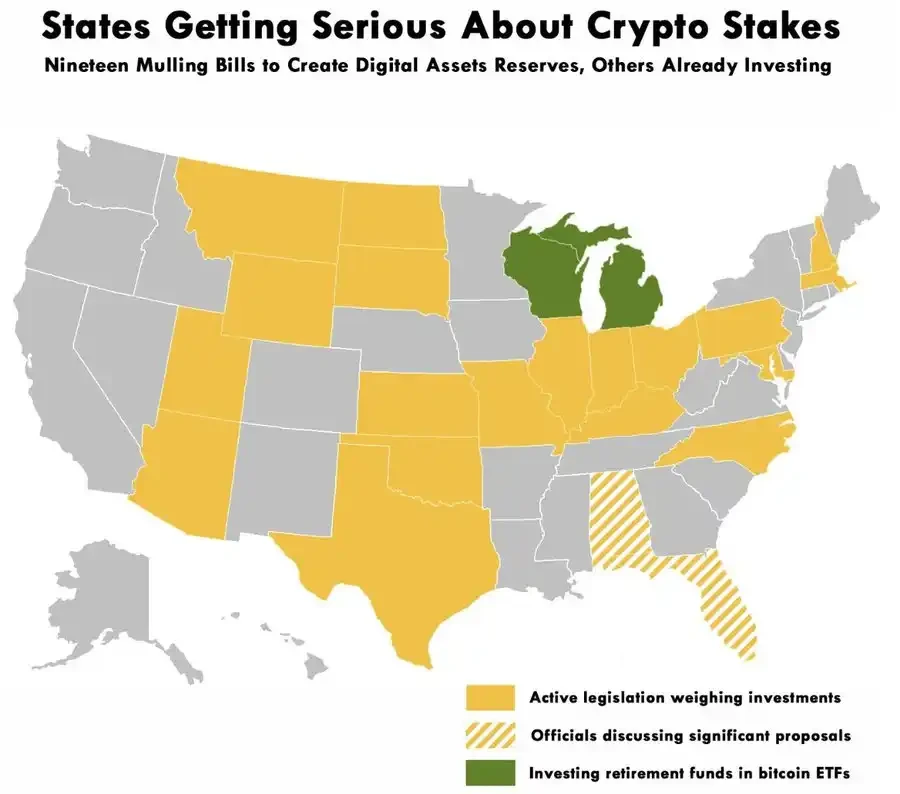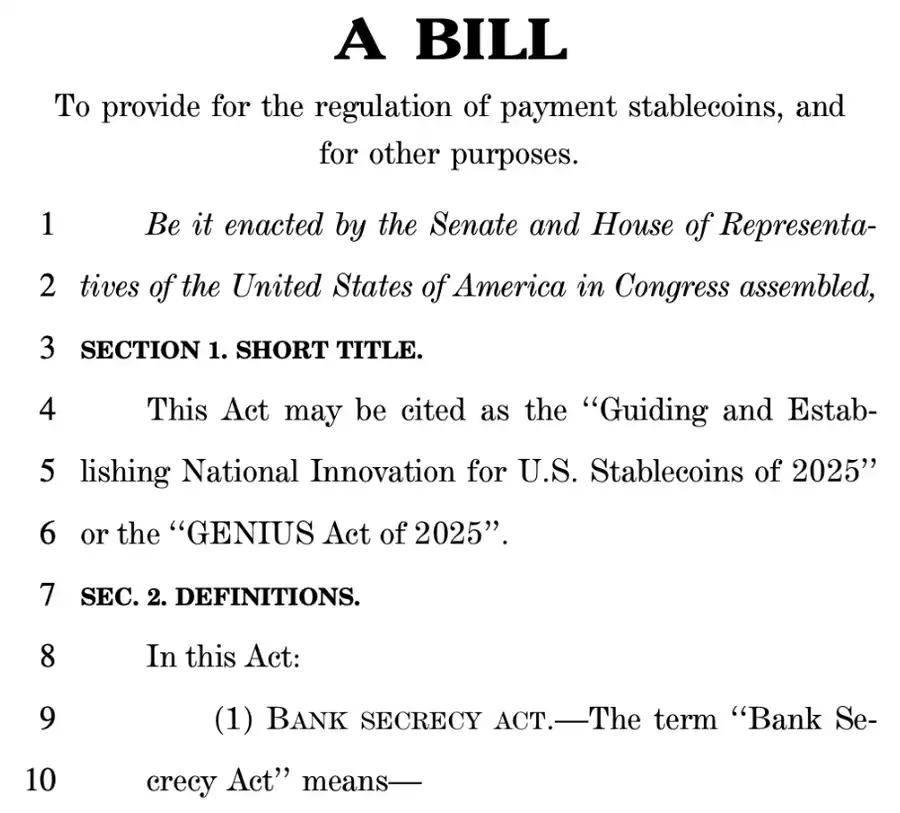Original Title: Crypto is Macro Again
Original Author: Marco Manoppo, Investor at Primitive Ventures
Original Translation: Ashley, BlockBeats
Editor's Note: The author analyzes how the crypto market will be influenced by macroeconomic and policy changes, particularly Trump's tax policies and inflationary pressures. As the Trump administration strengthens regulatory support for cryptocurrencies, including the CFTC's focus on fraud prevention and the FDIC's adjustments to banking policies, it may promote stability in the crypto market. In the coming months, stablecoin legislation and macroeconomic factors may dominate market trends.
The following is the original content (reorganized for readability):
Currently, the cryptocurrency market is no longer an isolated asset class. It is once again deeply intertwined with macroeconomic forces and regulatory changes. In the next 3-6 months, the dominant factors in the cryptocurrency market will be regulation and macroeconomics, rather than microeconomics or industry developments.
Since the launch of the $TRUMP token, cryptocurrencies have been steadily declining. The token was released on January 17, 2025, just days before Trump's second inauguration, sparking speculative sentiment but failing to sustain market gains.
Meanwhile, macroeconomic forces are also at play.
On February 1, 2025, President Trump imposed a 25% tariff on all goods imported from Mexico and Canada, a 10% tariff on Canadian energy exports, and an additional 10% tariff on Chinese imports. This move had an immediate impact on risk assets.
Since the introduction of these tariffs, the overall market capitalization of cryptocurrencies has decreased by about 13%, falling from $3.8 trillion to $3.3 trillion. Bitcoin itself rebounded to $96K after hitting a three-week low of $91K, while Ethereum and other major cryptocurrencies saw even steeper declines, reaching as high as 25%.

Why does the crypto market respond to tariffs?
Fear of Trade Wars and Risk Aversion
The threat of a global trade war has led investors to flee risk assets. Traditional finance (TradFi) investors view Bitcoin as a high-risk asset and are turning to safer assets like gold, bonds, and the dollar. A typical risk-averse trade is unfolding, categorizing cryptocurrencies within this framework.
Inflation and Interest Rates Back in Focus
Tariffs have increased the cost of imported goods, potentially leading to rising inflation. If inflation remains high, the Federal Reserve may delay or cancel expected interest rate cuts, reducing liquidity in financial markets. Since Bitcoin does not generate yield, higher interest rates make it less attractive compared to U.S. Treasury bonds or even cash deposits.
This dynamic contrasts sharply with the low-interest, liquidity-driven environment of 2020-2021, during which cryptocurrencies thrived. Thus, macro trends are once again the primary drivers affecting cryptocurrency performance.

The Role of Regulation and Traditional Finance
Although tariffs and inflation dominate the short-term outlook, regulatory changes are equally crucial. Global regulators are intensifying scrutiny of the crypto market, and the U.S. Securities and Exchange Commission (SEC) and the Commodity Futures Trading Commission (CFTC) have recently taken some industry-friendly actions, suggesting a more constructive regulatory attitude in the U.S.
Meanwhile, traditional financial institutions (TradFi) are accelerating their adoption of cryptocurrencies, recognizing their potential as a diversified asset class.
Matt Britzman from Hargreaves Lansdown notes that fears of a trade war triggered by tariffs typically dissipate quickly, but during this period, investors hedge through gold, Treasuries, and the dollar.
Similarly, Joel Kruger from LMAX Group points out that the market is not afraid of extreme tariff measures but is adapting to Trump's negotiation strategies.
This means that while volatility may be high in the short term, long-term investors may continue to accumulate Bitcoin and other cryptocurrencies during price declines.
What Might Happen in the Next 3-6 Months?
Cryptocurrencies have once again become part of the macroeconomic landscape. They are no longer independent of the fluctuations in traditional markets. Economic policies, central bank decisions, and geopolitical events directly impact the performance of digital assets.
As inflation, interest rates, and trade policies dominate the dynamics of financial markets, digital assets are no longer detached from the broader economic environment. Institutional funds now view major cryptocurrencies as part of the traditional finance (TradFi) sector, meaning that regulatory changes and global economic trends will shape the trajectory of cryptocurrencies.
In the coming 3-6 months, the market is expected to continue facing volatility as it digests tariff updates, Federal Reserve policy decisions, and upcoming regulatory measures.
The question is not whether cryptocurrencies will decouple from the macroeconomy, but how they will respond to this new reality.
What truly matters now are macro events and what Trump says regarding regulation.
The market is reacting sharply to trade policies, interest rate expectations, and regulatory decisions, all of which may shape the development trajectory of the entire industry in the coming months.
Key Regulatory and Macroeconomic Developments Driving the Cryptocurrency Industry
Cryptocurrencies Have Become a National Priority in the U.S.
President Trump signed an executive order designating cryptocurrencies as a national priority and established the "Presidential Working Group on Digital Asset Markets" to create a regulatory framework and assess the national digital asset reserve.
The order protects fair banking access for self-custodied and crypto businesses and explicitly prohibits the launch of a Central Bank Digital Currency (CBDC) in the U.S. It also rescinds the digital asset policies from the Biden administration, marking a shift in the U.S. regulatory stance towards supporting cryptocurrencies. The working group is led by David Sacks (the crypto czar).
Impact on Cryptocurrencies:
The refusal to launch a CBDC and support for privately backed stablecoins may benefit stablecoin issuers while limiting alternatives controlled by the government.
The industry's expectations for strategic Bitcoin reserves have not yet materialized, but the assessment of digital asset reserves suggests that the government may accumulate in the future.
Supportive Regulatory Team for Cryptocurrencies
Trump has nearly completed the formation of his cryptocurrency regulatory team, nominating Jonathan Gould (Office of the Comptroller of the Currency, OCC), Jonathan McKernan (Consumer Financial Protection Bureau, CFPB), and Brian Quintenz from a16z (Commodity Futures Trading Commission, CFTC).
These nominees have experience in cryptocurrency or financial regulation, indicating their support for a market-oriented stance.
While the Senate confirmation process may take time, the Trump administration is crafting a potentially more open regulatory framework for digital assets.
Impact on Cryptocurrencies:
Gould may push for bank licenses that support cryptocurrencies, while the CFTC under Quintenz's leadership may support blockchain innovation.
This marks a shift in the U.S. regulatory attitude, especially regarding the regulation of stablecoins and crypto banking, with clearer and more favorable regulatory policies likely to emerge in the future.
19 U.S. States and Endowment Funds Considering Bitcoin Investments

An increasing number of 19 U.S. states are considering legislation to invest public funds in Bitcoin. Some proposals allocate up to 10% of state funds to large-cap cryptocurrencies.
Wisconsin and Michigan have already included Bitcoin in public employee retirement portfolios, and another 23 states are actively debating similar proposals.
Meanwhile, U.S. endowment funds are also increasing their exposure to cryptocurrencies as digital asset prices soar to new highs.
Impact on Cryptocurrencies:
- State-level Bitcoin investments may enhance legitimacy, demand, and price stability, driving institutional adoption and accelerating regulatory clarity. If these laws pass, it will further integrate cryptocurrencies with public finances, but legislative approval remains a key hurdle.
Tokenization Pilot Program
Acting CFTC Chair Caroline Pham is advancing a tokenization pilot program that will use stablecoins as collateral.
She is organizing a CEO summit with leaders from Coinbase, Ripple, Circle, and other major crypto companies to discuss this initiative.
Impact on Cryptocurrencies:
If this pilot program is implemented, it will help legitimize stablecoins in traditional finance, enhance liquidity in the derivatives market, and promote the widespread use of tokenized assets.
By integrating blockchain-based collateral into regulated markets, this initiative may set a precedent for the CFTC to develop future policies supporting cryptocurrencies under its evolving leadership.
CFTC Now Focused on Fraud Prevention
CFTC Acting Chair Caroline Pham also announced a significant restructuring of the agency's enforcement division, shifting the focus from "regulating through enforcement" to "preventing fraud."
This restructuring reduces the number of task forces and consolidates enforcement work into two groups: a complex fraud task force and a retail fraud and general enforcement task force.
Impact on Cryptocurrencies:
- By focusing more clearly on preventing fraud rather than broadly cracking down, legitimate cryptocurrency companies may face fewer regulatory hurdles, promoting greater institutional participation and enhancing market stability.
"Rebanking" of Cryptocurrencies
FDIC Acting Chair Travis Hill announced a significant shift in the agency's cryptocurrency regulation, committing to reassess past guidance that discouraged banks from collaborating with crypto companies.
As part of this reform, the FDIC released internal documents showing that regulators had pressured banks to sever ties with cryptocurrencies.
Impact on Cryptocurrencies:
If the FDIC implements its supportive reforms for cryptocurrencies, banks may become more confident in collaborating with digital asset companies, improving financial service access for the industry.
This shift could enhance liquidity, encourage institutional adoption, and lay the groundwork for more balanced regulatory policies.
However, Senate hearings and ongoing political debates will determine the extent and speed of these changes.
SEC's Newly Established Cryptocurrency Task Force
SEC Commissioner Hester Peirce outlined the 10 priority tasks of the agency's newly established cryptocurrency task force, which aims to provide regulatory clarity for the crypto industry.
Key focuses include defining the distinction between securities and commodities, clarifying the rules for crypto lending and staking, and creating a more feasible registration process.
Impact on Cryptocurrencies:
More explicit classification rules and registration pathways may encourage greater institutional adoption and compliance with the law, while the agency's focus on fraud prevention aims to build market confidence.
However, due to ongoing litigation and policy reviews, true regulatory clarity may take some time to materialize.
Preliminary Formation of U.S. Stablecoin Rules

The U.S. is moving towards stablecoin regulation, with two competing bills currently in play: the House's STABLE Act and the Senate's GENIUS Act, which propose different frameworks but agree on strict compliance measures.
Both bills support privately issued, dollar-backed stablecoins and prohibit Central Bank Digital Currencies (CBDCs).
Key differences include:
Regulatory oversight (GENIUS allows states to regulate issuers until their market cap reaches $10 billion; STABLE allows for opting out of federal regulation if state rules meet standards)
Reserve requirements (STABLE allows the use of government bonds, bank deposits, and central bank reserves, while GENIUS also includes money market funds and reverse repos)
Consumer protection (GENIUS focuses on transparency and enforcement, while STABLE requires one-to-one reserves and prohibits algorithmic stablecoins)
Impact on Cryptocurrencies:
Stricter regulations may challenge Tether's dominance, as both bills require monthly audits, asset segregation, and stringent reporting, potentially forcing exchanges to delist non-compliant stablecoins, similar to the impact of the EU's MiCA.
These laws will pave the way for the legitimization of stablecoins, attracting institutional adoption while setting barriers for less transparent issuers. If passed, they will establish clear guidelines for stablecoin issuers, ensuring market stability and compliance.
Final Thoughts
So far, it is clear that the cryptocurrency market has become deeply embedded in the macro market. Currently, macroeconomic conditions and policies will drive price fluctuations in the coming quarters, rather than innovations within the industry.
While I previously mentioned Trump's supportive actions for cryptocurrencies, such as executive orders, the pardon for Ross Ulbricht, and the launch of meme coins, which have stimulated market optimism, many believe these factors are largely short-term optimizations and speculation-driven—what we need more are long-term fundamental catalysts to attract new capital inflows from traditional finance (TradFi).
Regardless of what Trump says, U.S. government policies will influence traditional financial participants' sentiment towards cryptocurrencies, thereby affecting broader market liquidity.
免责声明:本文章仅代表作者个人观点,不代表本平台的立场和观点。本文章仅供信息分享,不构成对任何人的任何投资建议。用户与作者之间的任何争议,与本平台无关。如网页中刊载的文章或图片涉及侵权,请提供相关的权利证明和身份证明发送邮件到support@aicoin.com,本平台相关工作人员将会进行核查。




